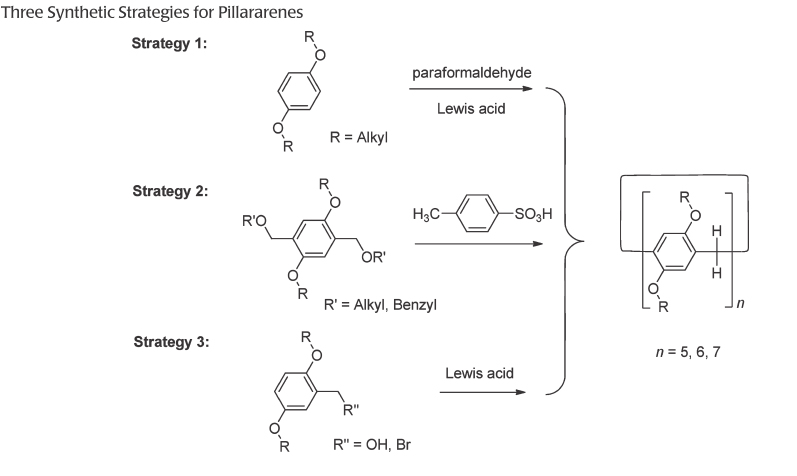Research Interests
Design and Preparation of Novel Host-Guest Recognition Systems, Fabrication of Molecular Machines
for Information Storage Materials, Design and Preparation of Supramolecular Polymers Based on
Noncovalent Interactions, Chemosensors, Preparation of Nano-Structures Based on Host-Guest
Chemistry and Metal-Coordination Chemistry.
Supramolecular Polymers
Supramolecular polymers, the combination of supramolecular chemistry and polymer science, can be defined as polymeric systems that extend beyond the molecule and utilize noncovalent interactions to direct their assembly, to control their conformations, and/or to define their behavior. Due to the reversibility of noncovalent interactions, these materials are capable of undergoing self-healing and adaptation processes, which afford supramolecular polymers a major advantage over conventional, covalently bonded polymers. The responsiveness to external stimuli may further provide a range of potential applications such as smart/adaptive materials and devices.
Depending on the different numbers of host and guest moieties in the monomers, which can further result in various topological features, supramolecular polymers can be classified as the following three main types:
(i) One-dimensional linear supramolecular polymers can be formed from complementary host and guest unimers. Two types of ditopic monomeric species that employ such unimers A (host) and B (guest) can be devised: either self-associating AB-type heteroditopic monomers or two-component equimolar mixtures of AA/BB-type heterocomplementary homoditopic monomers. Polyassociation of AB-type monomers yields supramolecular homopolymers, in which the initiation and growth occur immediately after generation of the host-guest recognition. On the other hand, regularly alternating supramolecular heteropolymers are formed upon mixing stoichiometric ratios of AA and BB. In both cases, the formation of cyclic oligomers will compete with that of the linear supramolecular polymers, which could be further regulated with the external conditions such as temperature as well as concentration.
(ii) Three-dimensional hyperbranched (dendritic type) supramolecular polymers can be derived from the unbalanced complementary host and guest unimers, such as AB2-type heterotritopic monomers or two-component mixtures of A2/B3-type hetero-complementary monomers. Although hyperbranched supramolecular polymers are regarded as ill-defined materials, they still have attracted interest due to their unique chemical and physical properties, such as easy synthesis, low melt and solution viscosity as well as high functionalization character.
(iii) Polytopic hosts and polytopic guests can be utilized to afford other macromolecular assemblies, such as star-shaped, dendronized as well as crosslinked supramolecular polymers, which can result in higher viscosity properties compared to their linear analogues.
Supramolecular polymers based on host-guest interactions exhibit novel properties and potential applications, some of which are listed below:
(i) Host-guest supramolecular polymers lead to various well-defined macromolecular architectures. As we know, chemists have mimicked the natural systems which combine the macromolecules and noncovalent interactions to afford defined and ordered topology. However, noncovalent interactions based on solvophobic, π-π and some hydrogen bonding interactions encounter non-directional or self-complementary problems, failing to afford controlled supramolecular macromolecular architectures. In contrast, the asymmetrical host-guest interactions provide highly directional and non-self-complementary properties. Therefore, it is highly efficient and economical to build the desired complex architectures such as block copolymers, star-shaped polymers and graft copolymers based on such interactions.
(ii) Host-guest supramolecular polymers can be used to prepare responsive materials with properties that can be changed/tuned by varying the environmental conditions. The reversible character of host-guest interactions suggests that the systems can be switched between the assembled and the disassembled states by external stimuli, such as temperature, pH, light, redox state or concentration. Therefore, polymers can be engineered with unprecedented macroscopic properties, allowing their application in stimuli-responsive materials. In addition, supramolecular compartmentalized polymers comprising multiple host-guest interactions can be utilized to switch under different parameters.
(iii) The host-guest complex can be interlocked to afford rotaxane- as well as catenane-type mechanically interlocked structures. Hence, the host-guest supramolecular polymers can be regarded as the intermediates for interlocked macromolecules such as poly[n]catenanes and daisy-chain poly[n]rotaxanes. The placement of the mechanical bond as an integal part of the polymer backbone can introduce potential unusual mobility elements such as elongational and rotational mobilities into its main chain, resulting in unusual viscoelastic properties. For example, very large modulus loss, low activation energy for viscous flow as well as rapid stress relaxation can be anticipated on account of the mobility elements present within these structures. Moreover, these polymers can serve as actuators and molecular muscles by controlling the elongation mobility in the polymers with external stimuli.
Pillararene
It is of continuing interest to design and synthesize novel macrocyclic host molecules because of their important roles in supramolecular chemistry. The successful examples include crown ethers, cyclodextrins, cucurbiturils, calixarenes, and their structurally similar scaffolds. Currently a new class of [1 n ]paracyclophanes is growing with similar composition but different structural features compared with calixarenes. This new class of macrocyclic molecules are made up of hydroquinone units linked by methylene bridges at para positions. Their descriptive name “pillararene” was coined by Tomoki Ogoshi in 2008.
